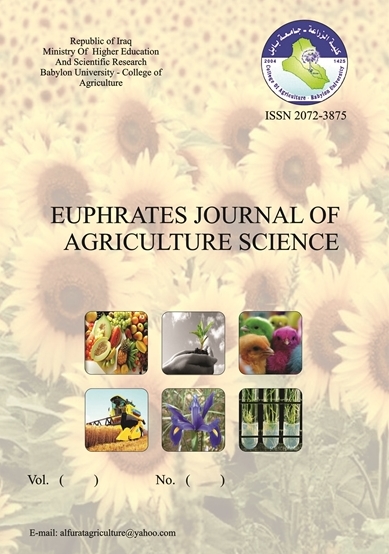Abstract
With the aim of evaluating the performance of genotypes of beans (Spanish, Italian, local) and testing them under two levels of plant density (80 and 160 thousand plants ha-1), and determining which genotypes give a higher yield and at what plant density, and calculating some of their genetic parameters, a field experiment was carried out in the winter season 2023-2024 in Station A in the Department of Field Crops - College of Agricultural Engineering Sciences-University of Baghdad-Al-Jadriya, a Randomized Complete Block Design (RCBD) was used with three replications, in a split plot arrangement. Plant densities represented the main plots and the secondary plots represented the genotypes. Studying the traits plant height, the number of branches, the number of leaves, the number of pods, the wet weight of the pods, the length of the pod, the number of seeds in it, the dry weight of the pods, the weight of 10 seeds, the plant yield, and the unit area yield. The results showed that there were significant differences between the plant densities, the high density excelled by giving its plants the highest mean yield per unit area was 16,802 tons/ha-1, due to the increase in the number of plants per unit area. The genotypes also differed significantly, and the Spanish genotype excelled in giving highest mean yield per unit area, reached to 14,950 tons/ha-1, followed by the local genotype with mean of 13,004 tons/ha-1, that the Spanish genotype was superior due to its superiority in yield components and giving it the highest pod length (21.00 cm) and the highest seed weight (15.67 g). The results also showed that the interaction was significant between the genotypes and plant densities for most of the studied traits. The results also showed that the values of genetic variation for most studied traits were higher than environmental variation at the two plant densities, with the exception of the traits of number of pod seeds and individual plant yield at low and high densities, respectively. Broad-sense heritability was high at low densities, reaching 99%, 87%, 96%, 88%, 61%, 96%, 98%, 99%, 99%, and 99% for the traits of plant height, number of branches, the number of leaves, the number of pods, the length of the pod, the number of its seeds, the weight of wet and dry pods, the yield of an individual plant, the weight of 10 seeds, and the yield of unit area, respectively. However, at high density, the heritability was high for the traits of plant height, number of leaves, number of pods, number of pod seeds, weight of wet and dry pods, weight of 10 seeds, and yield of unit area, reached 99%, 89%, 88%, 67%, 99%, 84%, 83% and 93%, respectively, which indicates the possibility of improving these traits through selection for their high genetic variation.
Keywords: Broad-sense heritability, Vicia faba L., genotypes.
